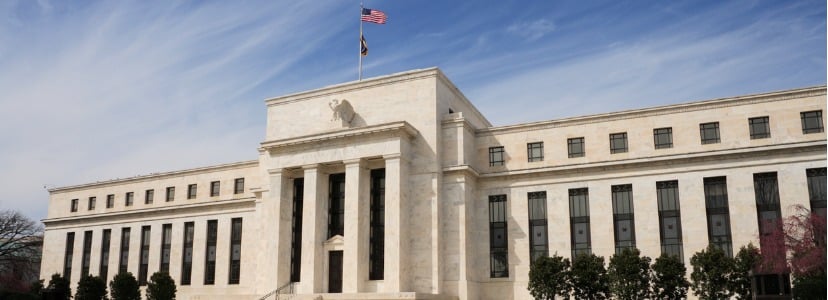The Fed Held Rates for Second Straight Meeting & Leaned Dovish

Another Hold & Hikes Still on the Table
The US Fed unanimously kept interest rates unchanged at 5.25-5.5% on Wednesday [1], as widely anticipated, marking its second hold in a row. Despite staying on the sidelines again, officials restated their commitment to restoring price stability and kept the door open to further tightening. During his press conference, Chair Powell dispelled the notion that the back-to-back pauses make a return to hikes difficult. [2]
Elevated Inflation & Strong Economy
Inflation has moderated substantially from the 2022 peak, but remains "elevated" and far from the 2% goal. Recent prints have shown persistence, with headline PCE steadying at 3.4% y/y in September and core easing only marginally to 3.7% y/y. Mr Powell warned once more that achieving the 2% target has "a long way to go" and that progress is going to be "bumpy".
In their September meeting, officials had embraced a soft landing and went a step further yesterday, upgrading their view on the economy. They noted its expansion at a "strong" pace, from the "solid" designation previously. The US grew by 4.9% in Q3 according the recent preliminary data, with the Fed Chair speaking of an "outsized" rate, which was boosted by a "surge in consumer spending". At the same time, the labor market is coming into better balance, but remains tight.
Dovish Tilt
The previous meeting had a hawkish bias and the projections implied another hike for the terminal rate to be reached, but recent softer remarks had undermined the higher-for-longer mantra. The data since then have generally pointed to strong economy, tight labor market and persistent inflation. Officials paused again though on Wednesday and it's hard to provide a hawkish messaging with two holds in a row.
Yesterday's decision had a clear dovish tilt to it and Mr Powell said that the risks of overtightening versus doing too little have gotten "more two-sided". Most Imprtantly, Mr Powell refrained from saying that the Fed's stance is not sufficiently restrictive to achieve price stability. This was a striking shift from the September press conference and his speech at the Economic Club of New York from only two weeks back. In both those appearances, he was unequivocal that policy is not sufficiently restrictive yet. [3]
Furthermore, the policy statement took note of tighter credit and financial conditions, with the latter being a new addition. Chair Powell said that this financial tightening is partly due to higher longer-term treasury yields. The 10-year hit 5% for the first time since 2007. These elevated rates are "showing through" to higher borrowing costs, which can weigh on economic activity and affect monetary policy.
To Hike or Not to Hike
The US Fed has delivered a massive amount of hikes in a short period of time, to the tune of 525 basis points since the March 2022 lift-off, in its most aggressive tightening cycle in decades. Monetary policy is at an intricate and highly uncertain phase, with the Fed and other central banks touting meeting-by-meeting approaches.
The Fed may have already done enough to restore price stability, given the lagging nature of the transmission mechanism, while the rising treasury yields enhance the reticence around further monetary restraint. Wednesday's outcome added to the hints that the Fed may be done hiking. Markets never embraced the one more hike projection and believe that rates have already peaked, even though they haven't completely priced out another increase in future meetings.
On the other hand, it's hard to the stay on the sidelines with an economy that continues to outperform and a still hot labor market, despite signs of cooling. These conditions sustain prospects for more tightening and prolonged restrictive stance and the Fed kept more moves on the table. Moreover, policymakers have overestimated inflation progress in the past and are hesitant to call it a day that could risk a de-anchoring of expectations.
Nikos Tzabouras
Senior Financial Editorial Writer
Nikos Tzabouras is a graduate of the Department of International & European Economic Studies at the Athens University of Economics and Business. He has a long time presence at FXCM, as he joined the company in 2011. He has served from multiple positions, but specializes in financial market analysis and commentary.
With his educational background in international relations, he emphasizes not only on Technical Analysis but also in Fundamental Analysis and Geopolitics – which have been having increasing impact on financial markets. He has longtime experience in market analysis and as a host of educational trading courses via online and in-person sessions and conferences.
References
| Retrieved 02 Nov 2023 https://www.federalreserve.gov/monetarypolicy/files/monetary20231101a1.pdf | |
| Retrieved 02 Nov 2023 https://www.youtube.com/watch | |
| Retrieved 04 May 2024 https://www.youtube.com/watch |


Any opinions, news, research, analyses, prices, other information, or links to third-party sites contained on this website are provided on an "as-is" basis, as general market commentary and do not constitute investment advice. The market commentary has not been prepared in accordance with legal requirements designed to promote the independence of investment research, and it is therefore not subject to any prohibition on dealing ahead of dissemination. Although this commentary is not produced by an independent source, FXCM takes all sufficient steps to eliminate or prevent any conflicts of interests arising out of the production and dissemination of this communication. The employees of FXCM commit to acting in the clients' best interests and represent their views without misleading, deceiving, or otherwise impairing the clients' ability to make informed investment decisions. For more information about the FXCM's internal organizational and administrative arrangements for the prevention of conflicts, please refer to the Firms' Managing Conflicts Policy. Please ensure that you read and understand our Full Disclaimer and Liability provision concerning the foregoing Information, which can be accessed here.